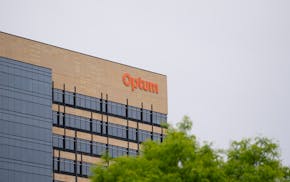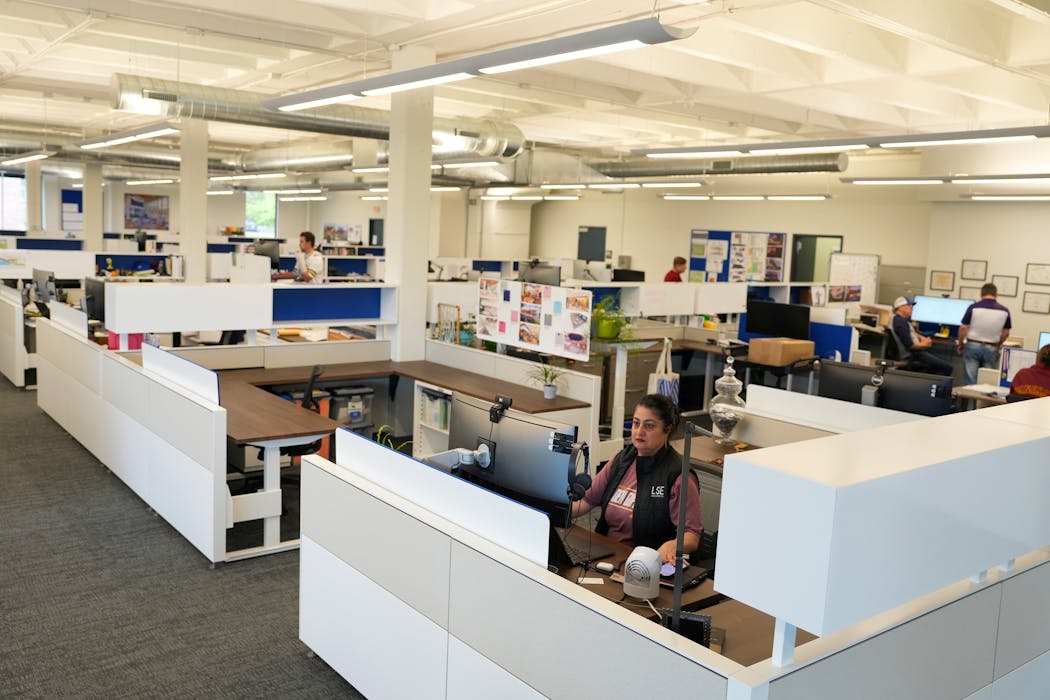Desperate to get their workers back under one roof, employers are increasingly turning to architecture and design to modernize offices as a lure for staffers.
With clients, "it's pretty rare that we don't have a conversation about how to get people back to the office," said Ashley Wurster, vice president of interior design for Minneapolis-based Ryan Cos., ninth among large companies on the Star Tribune's Top Workplaces list.
At least 85 to 90% of clients ask what amenities are now expected.
"If they are large enough, they have a global design team saying what they want to incorporate," she said.
Ryan manages more than 200 commercial properties mostly in Minnesota and Arizona, including City Center in downtown Minneapolis and 10 West End in St. Louis Park. It also handles design needs of clients such as JPMorgan Chase and others ranging from industrial settings to health care facilities.
Today's design trends are about appealing to workers who would rather be in their home offices, Wurster said.
"Everybody loves working at home because you can grab lunch at the dining room table," she said. "At home you get privacy and the [calmer] acoustics of a place that doesn't have a dozen co-workers sitting next to you."
Employers are focusing more on hospitality, trying to incorporate more break rooms or spaces that are homier than pre-pandemic office kitchens, she said. They also are focusing even more on wellness amenities such as fitness spaces and bike and shower facilities.
This is true even within warehouse and fulfillment centers, unheard of in the design mix a decade ago.
The new trend hearkens back to the 1980s and '90s, when corporations wanted employees to stay at work as long as possible. Back then, many insisted on providing workers on-site dry cleaning, meals, fitness centers and other concierge services.
It's all about convenience and comfort for employees who must give up some work/life flexibility to come to the office.
The shift is keeping Ryan, Perkins & Will and LSE Architects busy creating workspaces that give employees more than a desk, chair and storage. Workers want patios and garden areas, outdoor seating options, anything that gives more natural light.
LSE owners Quin Scott and Mohammed Lawal did their own assessment of facilities as they wondered how best to encourage their 55 headquarters employees to come to the office four days a week. They also wanted to foster better communication among them.
So the firm, which ranked 39th among small companies on the Top Workplaces list, spent $6 million to buy and renovate a former blueprint graphics printing plant on Glenwood Avenue. LSE moved its operations there in December.
Scott pointed around the open space. "We took out walls," he said, as he and Lawal cruised around on bicycles. Now there are 270-degree views of outside, including a direct view of downtown.
The open design with low-walled cubicles is meant to help employees collaborate on projects more easily. Clients include Gillette Children's Hospital, U.S. Bank Stadium, Satori Village, First Independence Bank and many schools.
Workers had direct input into the design so it meets their needs. That's important, Scott said.
"I don't think that hybrid work will go away. It has just become part of corporate America," he said. "But it's important to have spaces that work really well for employees while they are here."
One non-negotiable: lots of natural light, according to Scott and Lawal.
"I think that daylight is critical for people and their well-being," Scott said.
And so is a sense of community, Lawal said, noting that the architects arranged for employee discounts with neighboring barber shops, restaurants and the Eye Bobs business that rents out the first floor.
While LSE opted for an open collaborative space, other employers are opting for smaller nooks for focused "head down" time or small conference spaces where workers can huddle around a camera to connect with remote co-workers.
The massive high-end conference rooms of the past are getting design twists in this new hybrid work age, said Ted Campbell, Ryan Cos.' director of real estate management.
"Flex rooms" are becoming popular because they let businesses accommodate the ever-changing needs of a hybrid workspace, Campbell said.
In its headquarters in downtown Minneapolis, Ryan installed a foldable glass wall in one space, allowing it to transform from a conference room to a flex space extending all the way to the lunch room. By folding away the wall, there is space for dozens of people to gather, said Campbell, who is seeing clients make similar changes.
Some clients are choosing desks with wheels so space can be used differently when fewer workers are there, or when the purpose of meeting is different than everyday work.
While it may sound pricey, that's not necessarily the case, Campbell said.
Tenants are simply making trades, he said. Marble floors and high-end wall coverings may be swapped for the furniture, elaborate coffee/espresso stations and better Wi-Fi systems with better connectivity throughout the space.
One company covered its marble floors with artificial turf so employees could have indoor picnics in a park-like setting, Campbell said.
"lt used to be you designed for your clients who came into your office," he said. "But now, [corporations] are designing for their employees."
Anne Smith with Perkins & Will, 57th among small companies on the Top Workplaces list, sees a less visible trend emerging. The firm designed the interiors of the RBC Gateway tower that opened last year in downtown Minneapolis.
Companies are increasingly catering to the neurodiversity of workers and asking architects and designers to help.
"Neurodiversity is one topic getting a lot of attention right now," especially as employers strive to promote wellness and inclusion as part of their diversity initiatives, Smith said.
"There's research that shows something like 1 in 8 people are neurodiverse, so if you think of an organization with 800 people, 100 of them are hypersensitive to their building environment," she said. "Some people can be overstimulated very quickly if they walk into a place with funky patterns and colors and sound, so they can't bring their best selves and work."
Perkins & Will is creating workspaces with quiet "earthier acoustics" — using sound-dampening ceiling tiles or wall padding — or including spaces away from busy, distracting patterns or activities, Smith said.
"The idea is to offer everything — from being able to sit where you want to work for the day or sitting where you can get your best work done," Smith said. "It's about providing different spaces and choices so everyone can feel they are welcome and can be included in that environment."

DOGE cuts federal money for upgrades at Velveeta plant in New Ulm

Minnesota factories strained by new steel tariffs and ensuing chaos
'We don't want to lose this mine': Fear sets in for Iron Range miners as shutdown takes hold

UnitedHealth sues the Guardian, alleging defamation in coverage of nursing home care


